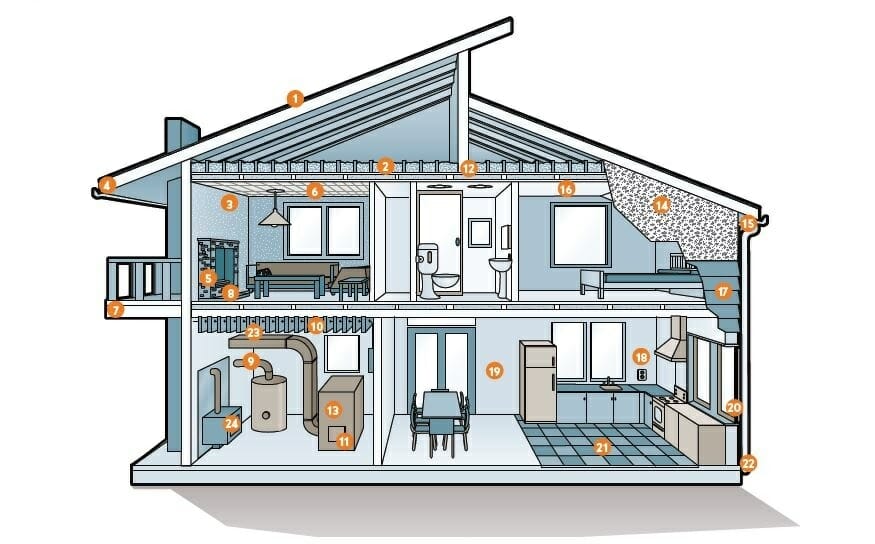Hazardous Material Report forms are required for all demolition and renovation permit applications for structures built prior to 1990.
Renovation or demolition permit applications for structures constructed prior to 1990 require a Hazardous Material Report form, as well as a hazardous materials survey. If hazardous materials are present, a WorkSafe BC Notice of Project must also be submitted.
Hazardous material means a hazardous substance, or material containing a hazardous substance, including asbestos-containing material, lead or any other heavy metal, or toxic, flammable or explosive material.
Determine if the structure in question was built prior to 1990, inspect the site, collect samples and test the material in accordance with WorkSafe BC – OHS Regulations 20.2.1(1) and (2).
Potential sources of asbestos in the home

- 1. Roof felt and shingles
- 2. Loose, blown-in insulation, such as vermiculite
- 3. Incandescent light fixture backing
- 4. Roof gutters can be made of asbestos cement
- 5. Artificial fireplace logs and ashes
- 6. Acoustic tiles
- 7. Deck under-sheeting
- 8. Asbestos pad under the fireplace hearth
- 9. Pipe insulation
- 10. Main panel and fuse box; each fuse wire has an individual asbestos flash guard
- 11. Door and gasket covers
- 12. Backing behind recessed lighting
- 13. Boiler and furnace insulation
- 14. Asbestos can be found in stucco
- 15. Soffit boards can be made of asbestos or asbestos insulation board
- 16. Textured or stipple-coated walls and ceilings
- 17. Asbestos cement (transite) board siding and undersheeting
- 18. Outlets and switches
- 19. Gypsum board filling compound, and patching and joint compound for walls and ceilings
- 20. Window putty
- 21. Flooring: vinyl tiles and linoleum sheet floorings: flooring adhesive
- 22. Downpipes can be made of asbestos cement
- 23. Insulation on electrical wires
- 24. Heat reflector for wood stove
WorkSafeBC minimum sample sizes for commonly tested materials
| Material | Minimum amount |
|---|---|
| Asphalt shingles | 5 cm x 5 cm (2 in. x 2 in.) |
| Roofing felt | 5 cm x 5 cm (2 in. x 2 in.) – All layers must be collected, down to the sheathing |
| Asbestos cement board | 5 cm x 5 cm (2 in. x 2 in.) |
| Floor rile, linoleum, asphalt flooring | 5 cm x 5 cm (2 in. x 2 in.) |
| Ceiling tiles | 5 cm x 5 cm (2 in. x 2 in.) |
| Mechanical insulation (piping) | 50 cm3 (3 cu. in.) – All layers must be collected, down to the pipe |
| Asbestos ropes, gaskets, wires, etc. | 5 linear cm (2 linear in.) or 5 cn x 5 cm (2 in. x 2 in.) |
| Levelling compounds and mortars | 50 cm3 (3 cu. in.) |
| Mastics and putties | 15 cm3 (1 cu. in.) |
| Texture coats and stucco | 50 cm3 (3 cu. in.) |
| Drywall mud | 5 cm x 5 cm (2 in. x 2 in.) – Mud only, do not onclude gypsum board or drywall tape |
| Vermiculite Insulation | 4 L (1 gal.) – Collect from the top to the bottom of the application to get a representative sample. |
| Sprayed insulation (for example, sprayed fireproofing) | 50 cm3 (3 cu. in.) |
| Other sprayed materials | 1 full, small zip-lock bag |
| Other non-friable products | 5 cm x 5 cm (2 in. x 2 in.) |
